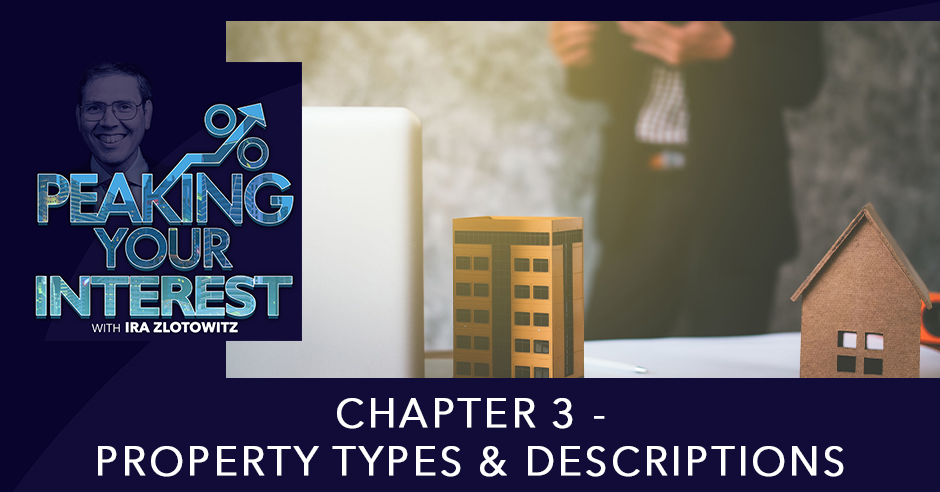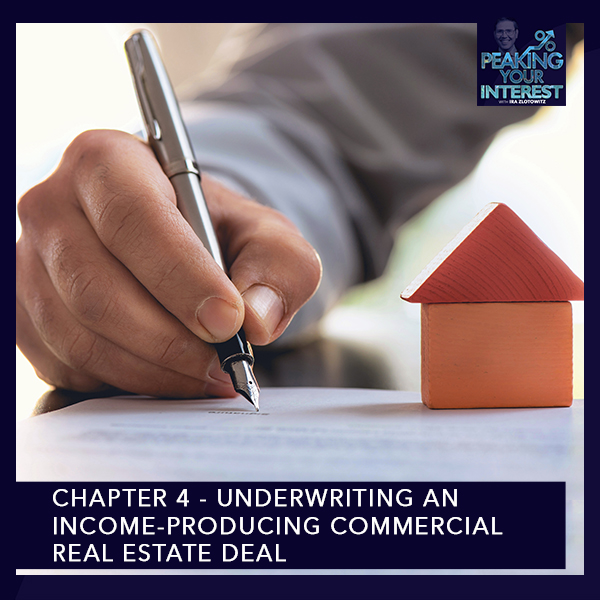Chapter 3 – Property Types & Descriptions
- On March 9, 2020

Getting into the real estate industry, it is critical to know the different property types and their descriptions. In this episode, Ira Zlotowitz teaches us how to differentiate residential properties from commercial properties. He also digs deeper into commercial real estate property types as he discusses the pros and cons of each type. Start to know the difference and learn which property type suits your real estate needs best.
—
Listen to the podcast here:
Chapter 3 – Property Types & Descriptions
Classifications Of Real Estate Properties
We’re going to discuss the different property types and descriptions. There’s a lot of confusion when it comes to commercial real estate. What’s included and what’s not included? Let’s break it down like this. What are the two classifications of real estate properties? The answer is 50,000 feet up in the air. Residential, which means 1 to 4 family homes. Every one of us that owns a home or lives in a home, that’s residential. There’s commercial. It is everything else except for owner-occupied of 1 to 4 family homes. That’s the two differences. This is where it gets a little tricky. If you have a five-unit building, it’s classified as multifamily. It’s also residential because these are homes and people live there, but it’s called multifamily, which falls under the umbrella of commercial.
When I would go up to speak to an audience, who are not commercial real estate people, I would say residential means homes and commercial means everything else. When I’m talking to a group of commercial real estate players, then I could use the word commercial, which means non-homes. Apartment buildings would be residential and multifamily, and commercial would be commercial. From going forward and we said the word commercial, it encompasses. Apartment buildings, office buildings, shopping centers will go through them and we do not include 1 to 4 family homes. However, as I mentioned in a previous episode, it became very popular, fix and flips. People hold on to these small units. If somebody owns a one-family house that he rents out, a two-family house that he rents out, that starts becoming a borderline.
It’s called an investment property. It ends up falling out under the commercial arena. I know this sounds confusing. There’s no real way to clarify it, but this is the best I could do under the circumstance and the most clarity I could possibly give over to you. From this point on, it’s smooth and a lot easier. In the commercial, what are the main property types? Let’s call it the core four. The four main property types. Those are apartment buildings, which are five units or more, office buildings, retail, which are shopping centers or retail stores and industrial properties. Why are they called the core four? Why are they called the main four? Why are these most popular property types? The answer is because these are the four property types that affect each and every one of us, every single day of our life.
We live somewhere that’s represented by an apartment building. We have to eat. We have to get food. We have to go shopping. That is a retail store. Even if you have Amazon online but it’s all back. There’s retail. There are stores at some level that always exist. We all have to work. We work in office buildings. In industrial properties, that’s where we can manufacture things. We could store things industrially. These are the four main property types. It also happens to be what makes real estate easy what people love about real estate. These four property types are logic-based. You don’t need a degree to own it. These tenants pay this income, these expenses, then I run the building. From a big picture view, we can relate to it. We all live in a home. We work in an office.
You could imagine you live through all parts of this entire process. If you have had a problem, someone comes to fix your problem. Do you pay them on a card? Is it part of the contract? That’s how it works. The other property types are mixed-use, which is the same as the core four, mixed up. The use is not just one, it’s a multiple-use. You could have a building, which has a store downstairs, apartments upstairs. That’s use of retail and apartment. It’s one of these property types that exist, but in the same building or the same property, there are two different uses. There’s a thing called single-tenant. It’s not a property type single-tenants because if it’s a retail store, let’s say we have a Walgreens. That’s the only tenant on the space. It’s retail, but it falls on the single-tenant because there are people out there who buy single tenants. Usually, single tenants are retail. That’s the lingo it goes to. That’s why when you see a sheet, they have an apprentice because it is retail or it’s whatever property type it is. It’s one tenant and there’s a bucket called the single-tenant and how people buy it. The last one is healthcare and hospitality.
The reason why it’s broken out separately. We do a lot of financing. We lead in that sector. A nursing home or a hospitality hotel is a blend of a business and real estate together. There is physical real estate there. At some level, there’s rent and the same lingo applies. On the other hand, you have to also know how to run a business. You can’t say, “I’ll take over a hotel. Are you part of any online place that sells some rooms?” Pricing models change based on the day, based on what occupancy is available. How many do you need to have a certain number of chambermaids or staff or no? Is it like an Uber-type of service? You have to learn about business print. You can take over your apartment building. If there are no tenants, you don’t have any real expenses. You have electricity and taxes. If you don’t have an ongoing maintenance expense to operate a building, for the most part, there’s a blend of a business. Therefore, even though it’s popular and there are tons of people that finance it, banks that we can deal with and people are buying. It’s a big industry, but it’s not straight up real estate. It is a mixed-use property, the same price as two property types. This is a business and a property mixed into one.
Residential means homes and commercial means everything else. Click To TweetWhere To Start
Where do you want to start with these property types? You made a decision. I like real estate. I like multifamily. I like retail. What’s the first step? Decide what size building you’re going to buy. There are three different starting points that you can get involved in. You can get involved in ground-up development construction. You can get involved in the dream, for the piece of rural land. I didn’t even have it assembled. I’m buying different pieces to put together an assembly that could build something big. If it doesn’t have approval, I go through the approval process. I’ll build it, take it up. I’ll build a property. You want to start with rural land. You could start with any step within the rural land, which typically falls on the bucket ground-up development. Which part of that do you want to start with?
The next step is to build. It’s income-producing. I want to buy an income-producing property. The next step is the value-add. It’s already a property, it’s income-producing. It’s fine, but there’s room for upside in this property like a value-added. Bring value to it is an example. The most common purchase is income-producing properties. Look around you, how much rural land do you see? How many buildings do you see? You see more buildings in rural land. These buildings when they sell are income-producing buildings. That income, expenses and cashflow in the building is called an income-producing property. It’s the easiest to relate to because you could buy the deal and check the expenses.
You can underwrite a deal and see what it’s worth. You have a lot of history about it. Sometimes the person says, “I didn’t make enough money. If I buy a building that’s already cashflowing, any person could buy it. It is easy to buy.” I’m willing to take a little more risk to the building around the corner. It has to be fixed up a little bit. It’s rented, but I’m sure if we did all the kitchens, the bathrooms and each unit, and you fix this up, you can then put in a few hundred thousand dollars in. You can increase the rent a little bit. It’s a value-add. You could add value to the property by doing certain things. That’s the second most common and it goes hand-in-hand because quickly it goes from cashflow, but it is not that great cashflow and growing income-producing property.
With the value-add within a year, typically, you’ll get it up and running perfectly. The other cycle is a ground-up development construction. What I find interesting is that there was never the same person. I never understood when I first came to the business. It’s been a long time until I got the correct answer. You rarely find the person that buys that first piece of rural land and makes it all the way to the finish line that keeps it to life. How come you only take it from here to here and sell it? B2C and sell? What does it take all the way to the end of the line? I realize that everything is based on risk-reward tolerance. If I could buy a piece of land for $1 million and go through all the zoning and all the approvals, four years later, I could sell it for $8 million. I had eight times my money. I’d rather do that if you want to keep it or move to a building that’s going to throw me off 10% a year.
I’d rather take that $8 million net of the taxes, whatever I do, then start again. I keep making that return. It’s a risk if you don’t get the approvals. For $8 million or it’s only worth $1 million or they can’t get the approvals worth barely $1 million. Even if it’s worth $1 million, I will carry it for a few years to cover those expenses. I’d rather take that risk for the home loan process. The person that buys income-producing does one deal with headaches in a city. He doesn’t want to deal with the headaches of construction. They don’t want to deal with different parts of the process that make much more sense to themselves. Once I saw and understand it, I took it to the next level.
A client of mine started with a thirteen-year and a fifteen-year building. One day he wakes up and says something, “I have a couple of buildings, a hundred units each.” I have eight buildings equal a hundred units. It’s not efficient for me. He sells those deals. It was a great deal. I met the person who bought it and said, “Ira, I bought the greatest deal in the world. That’s an upside. I could build it.” I’ve told myself, “The first guy is a smart guy. He left upside the table. He didn’t get every last dollar out of the deal that could be gotten.” I spoke to him and he goes, “Ira, you don’t understand. It wasn’t worth the headache.” I didn’t fight on a lot of different things there. I sold those buildings.

Property Types And Descriptions: You could add value to the property by doing certain things.
I’m in a contract for a hundred-unit building and on the same thing, the guy selling it to me. He left things on the table. It depends on what your starting point is. There’s through Eastern River and an affiliate company called Eastern Equities because you have to be licensed, for security license and it’s a separate business almost. In that business, I learned that when the smartest of real estate investors invest in deals, funds partner up with big real estate owners. When they buy deals, they live with the horizon. That was one of the coolest things we did on the app, where we were able on the full-blown underwriting and on a calculator, go through and see all the way down with IRRS and what the waterfalls look like.
When you go through it, this is way over your head. The cool part is I learned from there. It’s a reality check that when most investors make an investment, they say, “What’s the holding period? How long are we staying into this deal? Are we staying in this deal for 3, 5, 7, 10 years?” The typical hold period is 5 to 7 years. When I look at those numbers and I look at that holding period is because they want to say, “I’m buying this deal. I’m going to come in here, put money in to fix it up and get it done. I’ll stabilize it and get everything working,” and then it becomes boring afterward. I get a lot of growth in the first few years and it stables out. I want to always be in a growth mode. I’d rather sell it five years out when it’s all stabilized and buy another deal. That’s how they run their buildings.
Commercial Real Estate Versus Multifamily
What are some considerations of buying commercial real estate versus multifamily? There are a lot of different pointers. As time goes on, every time I give a course or a speech, this is the slide that changes the most because of new technologies, new things change. Let’s go simple and then technology is changing. They’re changing the habits of the people. They used to be, tell someone, “If you are going to order something online, you are crazy.” Now, you tell someone, “Could you imagine what it’s like before Amazon?” They go, “You’re crazy.” You speak to someone and they’re probably in their teens, in their twenties, they don’t remember the world before Amazon. These things are changing. People used to buy buildings and want to be near buildings that have grocery stores that is next to a train station, but because of Amazon, Uber, DoorDash, Netflix, Zelle caused the security tenant. There are many moving parts, the world is changing.
When you are buying these deals, you have to say to yourself, “I’m buying a deal in this area because of these things around me.” How important are all those things around a person anymore if he could press an Uber and get a car when he needs it? If he could go out, he doesn’t have to have a bank next to him. If he wants to transfer money, ha can go digital transferring of money. Many things are changing. With that, these are the considerations, how is it going to play a role in the building that you’re buying? Industrial in certain areas went much more expensive as per square foot basis. If you’re selling on Amazon, we have a store somewhere. You don’t need a retail location.
There are many different things I’m watching and it’s fascinating where things keep changing. You’re having the stores start offering the hybrids. You have a regular store that has a pickup through the internet and has a pickup location. Even the Walmart, instead of either you go online or a store, they’re figuring how to do the hybrid. As time goes on, these things are also going to keep changing. I personally think that when I go out to Florida when I go into Orlando, I never really use the apps that go shopping for you. Because in the stores that I shop in, in my local neighborhood, they’re not attached to it. I think it’s amazing. I can be on the plane and place the order and some of them deliver regular grocery bags.
If I was shopping myself at my door at that time, that has to change a perspective of where I care that the closest grocery stores are. It has to change after a while. When that company has enough, they know who’s buying that walking through the supermarket buying, it won’t be tied to a supermarket. They can get a warehouse much cheaper and stuck in a warehouse and deliver it that way. I’m sure there’s going to be the third part. There is the Amazon online, there’s the store, then there’s this new entity where they can deliver. Someone tells me about the pizza delivery business in Domino’s of how quickly it could deliver. They spent who knows how many millions to perfect how fresh the pizza stays in the store until your house.
You rarely find the person that buys that first piece of rural land and makes it all the way to the finish line that keeps it to life. Click To TweetWith technology and Uber, some other pizza shop that doesn’t have the resources, the R&D to put into, they can use the same technology and get there. When you start thinking about this, you have to take all the what-ifs and make a decision, how is it going to affect the buying habits and affect how many square footage of the store is needed and office space? At the same time, it’s where the tenants could live and not live based on the technologies and their habits of how they’re changing. The other piece of the puzzle for a commercial is commercial. The income is not evenly distributed. It’s not like an apartment building. Every one-bedroom is rent for these, two bedrooms for these and three bedrooms for these. By commercial, it can be based on the length of the lease, where the building you are, how much money does the landlord have to put into space in the beginning? There are many pieces, not evenly distributed. You can have one tenant be responsible for 40% of your income as opposed to an apartment building, pretty much with 40 units, roughly your 140th. You’re 137th, 145th, but you’re roughly within the same range.
Long-term or short-term lease to count market conditions and inflation. When you have an apartment building, you have 1 to 2 leases at a time that keeps on rolling. If you have a commercial building, a tenant wants to be in a ten-year lease. Depending on the lease terms you sign and the terms at lease, you can be messed up. What happens if inflation kicks in and your expenses go up? You’re in the type of lease where a gross lease, the tenant pays you to rent and that’s it. You’re responsible for expenses. When the rent goes up, what do you do? When your expenses go up, your income can’t go up. On the other hand, you might want a long-term lease. People are moving out of this area at least you had a long-term lease. This tenant is not going anywhere. Next is you have a gross lease or net lease.
Gross lease is when a tenant pays $18 afoot. $18 per year, $10,000 is the rent, $100,000 a rent, that’s what they pay. Other times, it’s no. The tenant says, “I’ll pay you $70,000 plus I’ll pay for my share of the expenses.” It’s even, but if the expenses keep rising, the tenant has to pay more. Sometimes one tenant is better, one is worse. Obviously, it’s a discussion. The reality between me and you is that, in any one subsection of a market, typically all the buildings are the same. This can be a difference overall in gross lease and net lease, but in this area where I live, all the buildings will be done a certain way. In the next neighborhood, we’ve done a different way. You have a choice, depending on what’s important to you and what you’re nervous about, that’s what you’d be willing to lock-in and not lock-in accordingly.
There are also considerations for commercial tenants. When a lease is signed, we sign an office space lease. Aside from the rent, those negotiations had three major points. How many months free rent? The landlord wanted market rent based on how long I signed the lease. They said for every X number of years you sign, you get free rent upfront for a month. I have a month to move in and not pay for rent. Number two, how much money is a landlord giving us called tenant improvement? The landlord is going to give me a certain amount of money upfront. It says, “You’re renting 20,000 square feet. I’m going to give you X number of dollars afoot to fit into this space?”
The third item is the leasing commission. Some brokers typically would have been introducing me to the landlord. The commission has to be paid to that broker. The reason why it is important to understand is that when you have an apartment building, a tenant leaves pretty much painting the unit. You might have to replace the carpet in some areas and clean it up. Maybe if something is damaged, fix it. When you have a commercial building, you can’t say, “It’s amazing. The rents here are averaging $18. I bring them to $20.” How much is it going to cost you to get that extra $2? It might not be worth it. That’s why I have different landlords sometimes say, “I’m renting the unit as is. You want to put in your space, I’ll give you a twenty-year lease. You fix it up a ten-year lease, you do what you want.” You have another landlord say, “No, I want the higher rent.”
When you come from financing, you’ll understand certain ways are better than others. These are big considerations that you have to realize when you’re buying commercial real estate. In retail, there is a thing called co-tenancy. This is a key point that most people don’t realize. As an outsider, it’s a new concept. When you rent an apartment building, you rent a unit if the building is empty and you’re happier. There are less people. There are fewer people to wait for the elevator. There’s a lot more parking available. The office building is the same thing. In retail, it’s the opposite. If I’m a tenant in a building with a store, I want it to be in every spot rented out because more people might come to a different store. Once they’re there, they’ll see my store. In co-tenancy, we rely on each other.

Property Types And Descriptions: Technology is changing the habits of people.
Many times when it comes to retail, the language is that certain leases have the right to walk away if the main tenant goes dark. If the main tenant leaves, if the occupancy goes low a certain number, that’s how they protect themselves. If I was going into a center that had a grocery store that was busy, the landlord would say, “I know the market is $12 afoot. I’m charging you $16 because it’s a hot center.” I’d say, “What if that tenant leaves? I could walk from at least.” There’s a lot of co-tenancy. You have to realize this language does apply and it’s scary in the world of Amazon because when a store started closing down, these co-tenancy things start kicking in a big way.
Let’s talk about the tenant types. What are the main commercial tenant types? The main commercial tenant type is called an anchor tenant. An anchor tenant is the one you’re building around. It goes in the lingo of retail. I have an anchor because of this one tenant. I know it’s rural. I’ll sign a long lease with the one tenant. This tenant will pay me with below market, but the security of a strong tenant. There will be a rural to the whole neighborhood and get other tenants here. Once I get this tenant signed, I’ll be able to sign up all the inline, the other spots. Sometimes an office building is the anchor tenant. I have an office building of 50,000 square feet. I have one tenant. The whole anchors at 30,000.
The bank is underwriting a deal or you’re buying it, you’re going to check how long the lease is. How strong is this one tenant to decide? At least, I know I’m covered with this as an anchor and everything else is icing on the cake. How much else do I need in order to cover the cake? Usually, the anchor tenant is a triple net lease long-term. The negotiation is the tenant pays less, but pay a percentage of the increased expenses going forward. This is where the landlord is protected. They’re the anchor. The landlord is protected also if the expenses go up. This anchor tenant will pay its share of the expenses. Another type of tenant is a credit tenant. This would be any tenant, but a tenant that has a credit. A tenant that you know they have a lease and they’re here to stay. A tenant you get rated by Moody’s or the S&P. It’s not about what the tenant is, it can be any tenants.
When a tenant gets a rent like a Walgreens. If someone came to the Walgreens and said, “Do you want to lease Walgreens with the tenant of a twenty-year lease or mom-and-pop pharmacy?” You’d rather have Walgreens but Walgreen knows it, so they’re going to say, “The market is $20 afoot. I’ll pay you $18. I’ll give you security for twenty-years. You can decide what it’s worth with the security.” I’ll talk about the added sophistication of structuring of leases were sometimes an 18,000 afoot from Walgreens based on financing is better than a 20,000 the other way. Even though you’re leaving actual money on the table here, the other perks outweigh that difference. You have mom-and-pop tenant stores. That’s what you typically see when you walk into a shopping center. If it’s not a name brand or credit tenants, it’s still a local nail salon, local pizza shop, a store that’s local. There are specialty tenants where a tenant has a specialty. They do a specific item that they sell.
The issue for a specialty tenant is going to be if the space is set up as a specialty tenant. When they leave, what does it take to reconfigure to a regular space? You can take a restaurant. It could be a specialty that’s used as a restaurant. If the restaurant left and you’re not going to rent it to another restaurant, it’s going to cost you a lot of money to regard it to a regular spot. Even if you did take it to another restaurant, is this a unique type of restaurant that the next person wouldn’t want it that way? Is it set up special? Specialty means was something special done for this use, and is there a market to get this market going on? The big question is short-term or long-term tenants, who benefits? At different times of the equations, sometimes it is better for the landlord or for a tenant. It becomes a discussion point. Thank you.




0 Comments